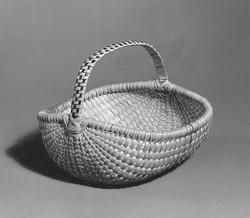Editorial board
The Centre for Folk Art Production (ÚĽUV) started to establish a network of producers working for the organisation in 1954. The organisation was identifying specific producers at places where the traditional production had appeared, or they trained in-house people in form of courses in individual types of production. The courses served to start production of a new product or as a mode of expansion of production of a popular product. Other types of courses were organised to revive some of the productions that had ceased to exist. Masters of folk art production and the ÚĽUV in-house experts worked as trainers for the courses.
The ÚĽUV introduced an apprenticeship-type of schooling for its workers in the 1960s. However, this type of education was viable only when a master of folk art production who was willing to train his son had been identified or when an entity organising the same type of production wanted to teach people for the purposes of the ÚĽUV. Not many masters used this opportunity and few apprentices continued the cooperation with the ÚĽUV.
The ÚĽUV purchased products from makers, the cooperation was not on the employment basis. Makers were entitled for health and social benefits and for family allowances, however, they were not entitled for absence leave. Remuneration was subject to the payroll tax. Producers made their products at home. Cooperation with the ÚĽUV was their only source of income, or they had other job except folk art production. In the course of time, rural makers stopped to be the only folk producers at the market. People of other occupations invented folk art production for themselves, too.
The ÚĽUV used various forms and activities to build up space and conditions for makers´ talents and abilities, predominantly by personal contacts of visual artists and researchers with producers. Makers met at all-Slovak meetings, seminars, trainings, instructions and received up-to-date information from an in-house magazine. Various competitions were organised to provoke creative endeavours of makers.
The initial range of goods comprised of articles, usually traditional older products that the ÚĽUV had purchased from the old rural makers. Cooperation with makers was established to work deliberately and produce the range of products that would have harmonised, both visually and functionally, with the contemporary needs.
Folk art products were offered to general public for purchase through The ÚĽUV exhibition halls and shops, first of which opened in December 1954 in Bratislava. Other shops opened later.
Things changed fundamentally in 1989. Makers started to do business outside the ÚĽUV. Therefore, the ÚĽUV had to identify new opportunities for its activities and also maintain all actual activities and accomplishments. Law amendments, revisions of economy rules and market opportunities during the last two decades defined forms of cooperation for both parties.
